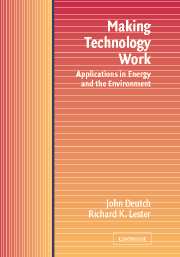Book contents
- Frontmatter
- Contents
- Preface
- 1 Introduction
- 2 Gasohol
- 3 Solar Thermal, Windpower, and Photovoltaic Technologies
- 4 Electricity from Coal
- 5 Controlling Acid Rain from Coal-fired Power Plants
- 6 Greenhouse Gases and Global Warming
- 7 Nuclear Power and Its Fuel Cycle
- 8 Managing Nuclear Waste
- 9 Nuclear Power and Weapons Proliferation
- 10 Natural Gas
- 11 Safety and Risk: Examples from the Liquefied Natural Gas and Nuclear Industries
- 12 Synthetic Fuels
- 13 Fuel Cells For Automobiles
- 14 Energy Models and Statistics
- 15 The Government's Role in Innovation
- 16 Conclusions
- Index
4 - Electricity from Coal
Published online by Cambridge University Press: 10 December 2009
- Frontmatter
- Contents
- Preface
- 1 Introduction
- 2 Gasohol
- 3 Solar Thermal, Windpower, and Photovoltaic Technologies
- 4 Electricity from Coal
- 5 Controlling Acid Rain from Coal-fired Power Plants
- 6 Greenhouse Gases and Global Warming
- 7 Nuclear Power and Its Fuel Cycle
- 8 Managing Nuclear Waste
- 9 Nuclear Power and Weapons Proliferation
- 10 Natural Gas
- 11 Safety and Risk: Examples from the Liquefied Natural Gas and Nuclear Industries
- 12 Synthetic Fuels
- 13 Fuel Cells For Automobiles
- 14 Energy Models and Statistics
- 15 The Government's Role in Innovation
- 16 Conclusions
- Index
Summary
Coal is by far the most plentiful of conventional fossil fuels. The world's total coal resources have been estimated to be as much as 10,000 billion tons – enough, in principle, to meet all of the world's energy needs for 1000 years at current rates of consumption. Coal, moreover, is widely distributed. The largest known resources are in Russia and other nations of the former Soviet Union, the United States, and China, but many other countries in every continent have sizeable deposits.
In the United States, coal is the largest energy-producing industry, accounting for nearly a third of all domestic energy production and almost a quarter of all energy consumed. The industry is a net exporter, and employs about 80,000 miners in 26 states.
The most important use of coal today in the United States and around the world is for electricity generation (see Figure 4.1). Of the billion tons of coal consumed annually in the United States, 90% is used in electric power stations, and these coal-fired plants generate more than half of the nation's electricity (see Table 4.1).
These figures make clear that coal will be an important fuel source and industry for many decades. However, there is growing awareness of the health and, especially, the environmental problems associated with its use. In this chapter we examine the technical and economic aspects of coal-fired electricity generation.
- Type
- Chapter
- Information
- Making Technology WorkApplications in Energy and the Environment, pp. 49 - 65Publisher: Cambridge University PressPrint publication year: 2003



